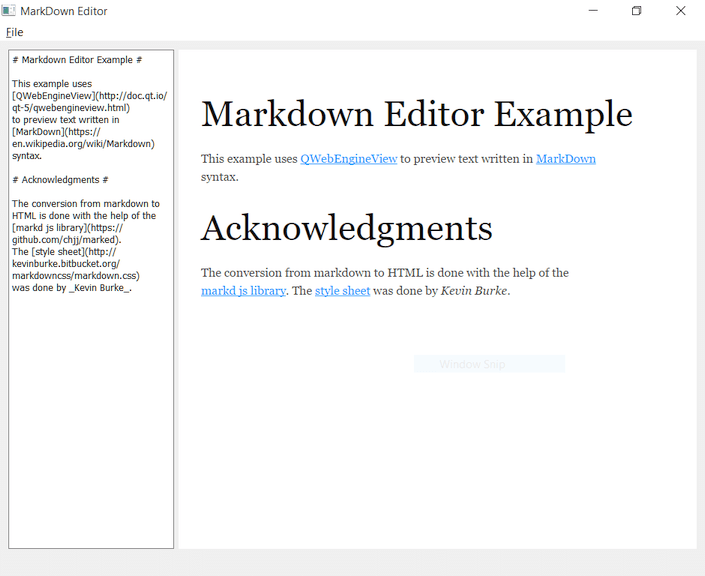
Demonstrates how to integrate a web engine in a hybrid desktop application.

Markdown Editor demonstrates how to use QWebChannel and JavaScript libraries to provide a rich text preview tool for a custom markup language.
Markdown is a lightweight markup language with a plain text formatting syntax. Some services, such as github, acknowledge the format, and render the content as rich text when viewed in a browser.
The Markdown Editor main window is split into an editor and a preview area. The editor supports the Markdown syntax and is implemented by using QPlainTextEdit. The document is rendered as rich text in the preview area, which is implemented by using QWebEngineView. To render the text, the Markdown text is converted to HTML format with the help of a JavaScript library inside the web engine. The preview is updated from the editor through QWebChannel.
To run the example from Qt Creator, open the Welcome mode and select the example from Examples. For more information, visit Building and Running an Example.
Because we expose the current Markdown text to be rendered to the web engine through QWebChannel, we need to somehow make the current text available through the Qt metatype system. This is
done by using a dedicated Document class that exposes the document text as a Q_PROPERTY:
class Document : public QObject { Q_OBJECT Q_PROPERTY(QString text MEMBER m_text NOTIFY textChanged FINAL) public: explicit Document(QObject *parent = nullptr) : QObject(parent) {} void setText(const QString &text); signals: void textChanged(const QString &text); private: QString m_text; };
The Document class wraps a QString to be set on the C++ side with the setText() method and exposes it at runtime as a text property with a
textChanged signal.
We define the setText method as follows:
void Document::setText(const QString &text) { if (text == m_text) return; m_text = text; emit textChanged(m_text); }
We implement our own PreviewPage class that publicly inherits from QWebEnginePage:
class PreviewPage : public QWebEnginePage { Q_OBJECT public: using QWebEnginePage::QWebEnginePage; protected: bool acceptNavigationRequest(const QUrl &url, NavigationType type, bool isMainFrame) override; };
We reimplement the virtual acceptNavigationRequest method to stop the page from navigating away from the current document. Instead, we redirect external links to the system browser:
bool PreviewPage::acceptNavigationRequest(const QUrl &url, QWebEnginePage::NavigationType /*type*/, bool /*isMainFrame*/) { // Only allow qrc:/index.html. if (url.scheme() == QString("qrc")) return true; QDesktopServices::openUrl(url); return false; }
The MainWindow class inherits the QMainWindow class:
class MainWindow : public QMainWindow { Q_OBJECT public: explicit MainWindow(QWidget *parent = nullptr); ~MainWindow(); void openFile(const QString &path); protected: void closeEvent(QCloseEvent *e) override; private slots: void onFileNew(); void onFileOpen(); void onFileSave(); void onFileSaveAs(); private: bool isModified() const; Ui::MainWindow *ui; QString m_filePath; Document m_content; };
The class declares private slots that match the actions in the menu, as well as the isModified() helper method.
The actual layout of the main window is specified in a .ui file. The widgets and actions are available at runtime in the ui member variable.
m_filePath holds the file path to the currently loaded document. m_content is an instance of the Document class.
The actual setup of the different objects is done in the MainWindow constructor:
MainWindow::MainWindow(QWidget *parent) : QMainWindow(parent), ui(new Ui::MainWindow) { ui->setupUi(this); ui->editor->setFont(QFontDatabase::systemFont(QFontDatabase::FixedFont)); ui->preview->setContextMenuPolicy(Qt::NoContextMenu);
The constructor first calls setupUi to construct the widgets and menu actions according to the UI file. The text editor font is set to one with a fixed character width, and the QWebEngineView widget is told not to show a context menu.
PreviewPage *page = new PreviewPage(this); ui->preview->setPage(page);
Here the constructor makes sure our custom PreviewPage is used by the QWebEngineView instance in ui->preview.
connect(ui->editor, &QPlainTextEdit::textChanged, [this]() { m_content.setText(ui->editor->toPlainText()); }); QWebChannel *channel = new QWebChannel(this); channel->registerObject(QStringLiteral("content"), &m_content); page->setWebChannel(channel);
Here the textChanged signal of the editor is connected to a lambda that updates the text in m_content. This object is then exposed to the JS side by QWebChannel under the name
content.
ui->preview->setUrl(QUrl("qrc:/index.html"));
Now we can actually load the index.html file from the resources. For more information about the file, see Creating an Index File.
connect(ui->actionNew, &QAction::triggered, this, &MainWindow::onFileNew); connect(ui->actionOpen, &QAction::triggered, this, &MainWindow::onFileOpen); connect(ui->actionSave, &QAction::triggered, this, &MainWindow::onFileSave); connect(ui->actionSaveAs, &QAction::triggered, this, &MainWindow::onFileSaveAs); connect(ui->actionExit, &QAction::triggered, this, &QWidget::close); connect(ui->editor->document(), &QTextDocument::modificationChanged, ui->actionSave, &QAction::setEnabled);
The menu items are connected to the corresponding member slots. The Save item is activated or deactivated depending on whether the user has edited the content.
QFile defaultTextFile(":/default.md"); defaultTextFile.open(QIODevice::ReadOnly); ui->editor->setPlainText(defaultTextFile.readAll()); }
Finally, we load a default document default.md from the resources.
<!doctype html>
<html lang="en">
<meta charset="utf-8">
<head>
<link rel="stylesheet" type="text/css" href="3rdparty/markdown.css">
<script src="3rdparty/marked.js"></script>
<script src="qrc:/qtwebchannel/qwebchannel.js"></script>
</head>
<body>
<div id="placeholder"></div>
<script>
'use strict';
var placeholder = document.getElementById('placeholder');
var updateText = function(text) {
placeholder.innerHTML = marked(text);
}
new QWebChannel(qt.webChannelTransport,
function(channel) {
var content = channel.objects.content;
updateText(content.text);
content.textChanged.connect(updateText);
}
);
</script>
</body>
</html>
In the index.html, we load a custom stylesheet and two JavaScript libraries. markdown.css is a markdown-friendly stylesheet created by Kevin Burke. marked.js is a markdown parser and compiler designed for speed written by Christopher Jeffrey and qwebchannel.js is part of the QWebChannel module.
In the <body> element we first define a placeholder element, and make it available as a JavaScript variable. We then define the updateText helper method that updates the content
of placeholder with the HTML that the JavaScript method marked() returns.
Finally, we set up the web channel to access the content proxy object and make sure that updateText() is called whenever content.text changes.
The example bundles the following code with third-party licenses:
| Marked | MIT License |
| Markdown.css | Apache License 2.0 |